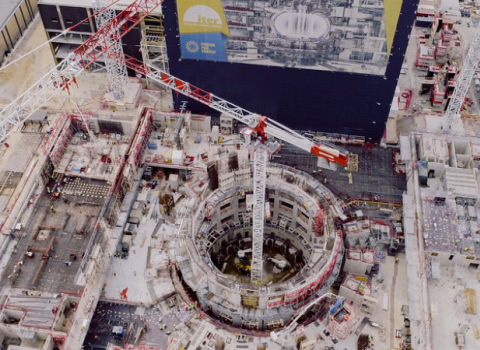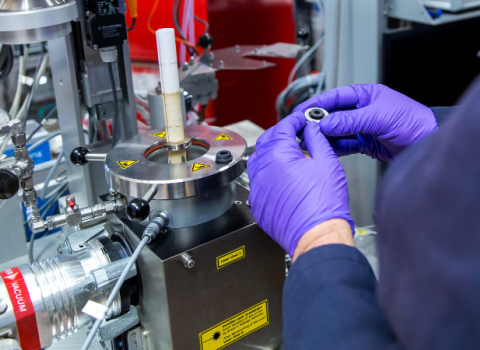Following cuts to physics, astronomy and other infrastructure projects, critics ask: is the US still reliable in global science?

Inside CERN’s Large Hadron Collider, up for budget cuts under Trump’s 2026 budget. Photo credits: Maximilien Brice / CERN
With steep budget cuts already upending the US science world, the Trump administration is now taking aim at global science, including US collaboration with Europe’s CERN particle accelerator and other “big science” labs.
The proposed cuts, detailed on May 31 in Trump’s 2026 budget plan to Congress, stunned scientists around the world for whom the US has been a key collaborator.
At CERN, where US money and science aided the lab’s famed 2012 discovery of the Higgs Boson, one former official said the cuts may slow some CERN work, but will mainly disrupt American physics and talent. It’s a case of the Americans “shooting at their own feet,” said Peter Jenni, former head of a leading CERN experiment.
In Washington, Democrats with an interest in science also reacted strongly. Congressman Bill Foster, a physicist whose Illinois district is home to the Fermilab particle accelerator, estimated the total cuts in fundamental research that Trump proposes for 2026 at more than $25 billion. That, he said in an interview with Science|Business, is going to put parts of US science “on life support.” And for foreign research partners, Foster said, it “calls into question whether the US is a reliable partner for any of this.”
The science cuts are among thousands of changes, great and small, listed in Trump’s proposals for the US fiscal year ending 30 September 2026, and come on top of a barrage of other cuts ordered for the current year, in some cases blocked temporarily by courts. The overall 2026 budget would reduce federal spending in hundreds of categories from healthcare to clean energy, with the notable exception of defence. Indeed, Foster noted that the $25 billion basic-science cut is about the same size as Trump’s proposed budget to create a new anti-missile system, the Golden Dome.
“In my view, a lot of this was done in order to fund this Golden Dome boondoggle,” he said.
Hearings and debate on the 2026 budget are just getting underway on Capitol Hill, even as the Republican-controlled Congress is still battling within its own ranks over the current, 2025 budget. But, Foster said, unless enough Republicans revolt against Trump, “I fear that a big fraction of it will get through.”
Notable in the 2026 plan is its attention to international science. There have been several smaller or temporary measures since Trump’s January 20 inauguration: the National Institutes of Health halting new foreign “sub-award” grants to foreign partners of US universities, and the State Department suspending new visa interviews for foreign researchers entering the US, both billed as temporary measures while new security systems are set up. But wholesale slashing of international research infrastructure and projects is new in the 2026 budget.
The CERN cuts
The CERN cut is a particularly striking case. The lab, near Geneva, was created in 1954 as a science-for-peace project uniting all the former belligerents in top-end, high-energy physics research. Since then, it has grown to 24 member-states, involving thousands of physicists, computer programmers and engineers from across the globe. One of the two biggest ongoing experiments, Atlas, has about 2,900 researchers from around the globe working together, including about 500 Americans, says Jenni.
Over the years, CERN has become the global leader in smashing subatomic particles to understand the nature of matter, energy and the universe. Its most famous exploit was finding firm evidence in 2012 of the Higgs boson. The academic paper announcing the discovery had more than 5,000 named co-authors from around the world; and the theorists behind the research won the Nobel Prize in physics.
The US has been involved in CERN for at least 50 years, currently as an observer rather than a member; full membership would require Congress to pledge money beyond its regular, annual funding cycle, a political impossibility in Washington. But even so, Jenni says, over the years the US has contributed more than $500 million to help build, operate and do experiments on its current particle collider - and its importance to US physics soared in the 1990s after the US cancelled its own rival accelerator project, the Superconducting Supercollider.
It has also been a mainstay of science diplomacy: during the Cold War, it was one of the few places that physicists from east and west could meet. That multi-cultural scene still matters for “soft” diplomacy, observes John Wood, former chair of the EU’s research-infrastructure planning body and today a CERN consultant. “If you go into the [CERN] cafeteria, you hear 500 languages, people working together, young people learning to live with another. If you want a soft approach to peace, then international science is the way to do it.”
Then there are practical benefits. CERN “has a history of innovation,” says Cole Donovan, a former Biden White House aide, now associate director of the Federation of American Scientists. The World Wide Web originated there with British computer scientist, Tim Berners-Lee. In medicine, magnetic resonance imaging and proton therapy for cancer were advanced by technical work for CERN. Says Donovan: “Proton therapy is literally a proton accelerator that you’re sticking yourself in front of; and when we build a big one in physics, that drives down the cost” later on when industry picks up the technology for medicine.
The budget cuts
But that does not matter, it appears, in the Trump 2026 budgets for the National Science Foundation and the Energy Department’s science office, the two main sources of US funding for CERN. They would cut support for the Large Hadron Collider (LHC) to $12 million in fiscal year 2026 from $20.5 million in 2024 and a similar amount in 2025, though Congress is still arguing about those numbers. It says the cut also means “participation of US researchers in LHC research will be commensurately reduced, and NSF expects similar reductions for software and computing capability for analysis.”
At the same time, the Energy Department’s budget line for accelerator R&D, $29 million in 2024, would be eliminated in 2026 and rolled into another budget line called “high energy physics” with a cut of its own, of $98 million, reducing the total to $1.1 billion.
Getting to the why or how of these cuts is, at present, virtually impossible. The Energy Department document offers no explanation, and its press office didn’t respond to Science|Business questions. An NSF spokesperson emailed a canned statement that the agency’s overall budget “reflects a strategic alignment of resources in a constrained fiscal environment in which NSF prioritises investments that can have the greatest national impact.” And the White House’s main budget documents are even more opaque.
Related articles
- European research projects hit by halt to NIH sub-awards
- EU remains committed to global collaboration on microchips
- Don’t feel guilty about poaching scientists fleeing Trump, US science body tells Europe
Part of the problem, says Donovan, who used to help negotiate US-CERN deals in the past, is that the cuts are coming so fast and furious from the White House that the agencies themselves aren’t sure what’s happening or why. The NSF’s director resigned in April, in apparent disagreement with the Trump orders.
Either way, the timing of the cut is especially unfortunate for CERN. It is in a lengthy battle to persuade its member and observer states to upgrade the LHC and prepare for its next big machine in the 2030s. And, as Congressman Foster notes, weak or absent US support will complicate that effort. At the same time, Jenni, the former CERN official, notes that the EU is right now trying to update its own strategy for particle physics. The absence of American physicists and engineers in the planning will not help.
At present, CERN is officially mum. A spokesperson emailed Science|Business: “For the moment, we do not see any impact on CERN’s research programme and cannot comment on the future.”
And more cuts…
Of course, CERN isn’t the only possible loser in this Washington numbers game.
Other big-science cuts in the NSF budget include a drop from $48 million to $29 million for one of the biggest US research infrastructures, the Laser Interferometer Gravitational Wave Observatory, or LIGO. At two underground sites in Hanford, Washington and Livingstone, Louisiana, physicists look for evidence of gravitational waves predicted by relativity theory. But they aren’t alone. As with CERN, so with LIGO there’s a network of foreign partners including the European Space Agency, Italy’s national nuclear institute, and Germany’s Max Planck Society. The NSF document – again, providing no explanation – says it will fund only one of the two existing sites and support “a reduced level for technology development” at the other.
Ocean research, perhaps because of its relation to Trump-targeted climate research, would see its NSF budget hacked, with the large US academic research fleet cut from $153.6 million down to $92 million.
In astronomy, cuts appear likely to ripple through the field, with three big astronomical projects on the block: a radio astronomy consortium, a solar observatory and an infrared observatory. Combined, their NSF budgets would fall to $141 million from $202 million. A spokesperson for the American Astronomical Society, asked for comment, emailed: ”Cuts to funding for astronomical scientific facilities by this budget proposal will hurt US leadership in many of these scientific efforts and risks eroding trust for engaging in future international collaborations.”
The diplomatic fall-out
Science diplomacy is an important part of these projects. The infrared project operates telescopes in Arizona, Hawaii and multiple sites in Chile, and has as co-funder France’s state Centre National de la Recherche Scientifique, plus various organisations in Latin America as scientific partners.
One of the Chilean telescopes, named after US dark-matter astronomer Vera Rubin, is due to come on line in 2026 after years of international planning and construction. The aim: with what it calls the world’s biggest camera to take millions of images of the southern sky, locating 10 to 100 times as many stars as previously seen. It will also be on the watch for asteroids and other objects on collision course for Earth.
The Trump budget would continue to fund the Rubin lab coming on line; but it would halt funding for associated radio-astronomy work at Kitt Peak and at one of the Chilean facilities, and operate two other facilities at just 50% capacity.
This kind of rapid-fire policy change, particularly after so much diplomatic preparation, doesn’t win the US any friends, critics warn. Observes Jenni, the former CERN official: “Things can be destroyed very quickly in international cooperation. To reestablish this will not be so easy.”
Diane M. Fresquez contributed to this article.





 A unique international forum for public research organisations and companies to connect their external engagement with strategic interests around their R&D system.
A unique international forum for public research organisations and companies to connect their external engagement with strategic interests around their R&D system.